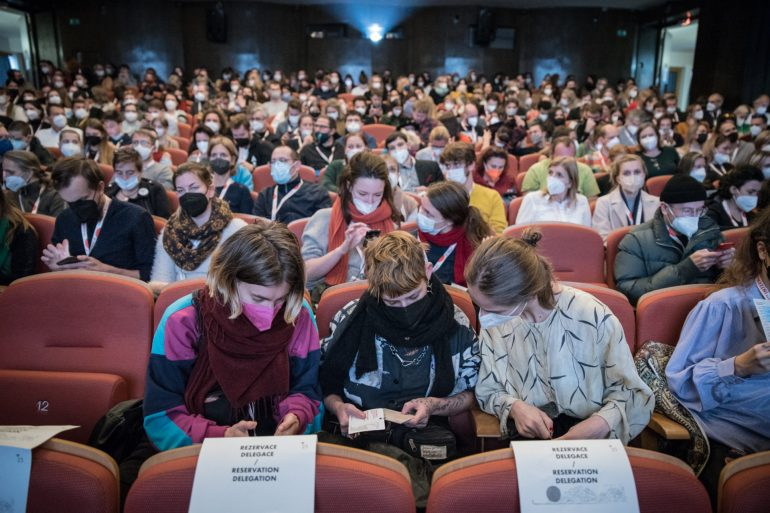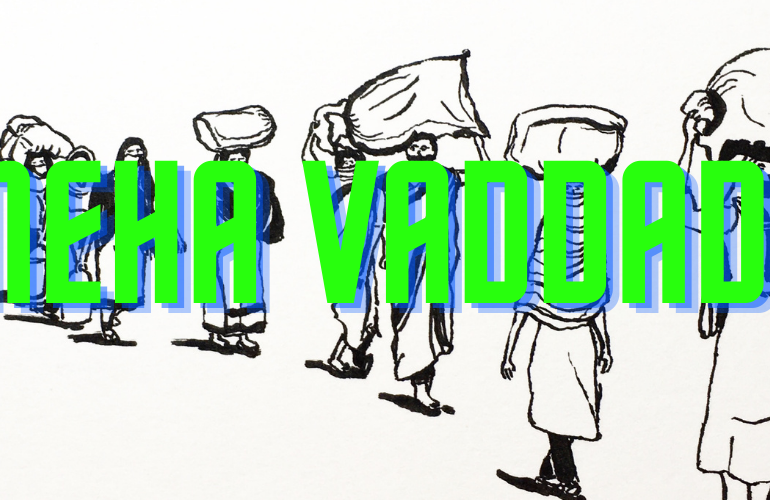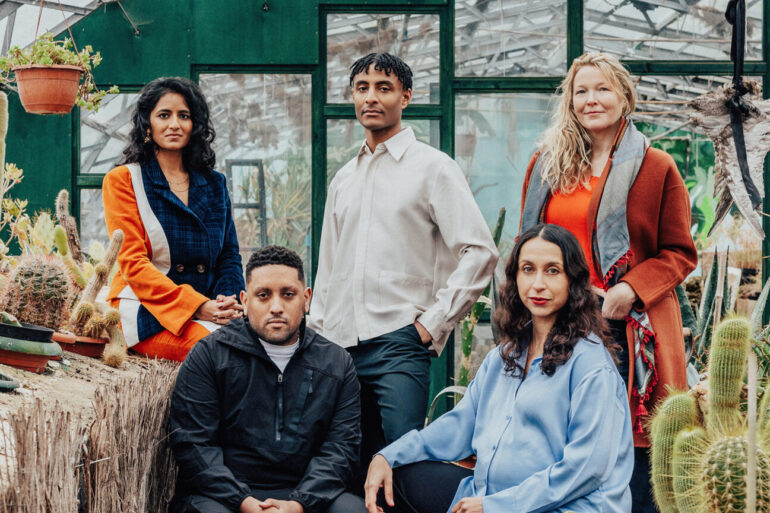When I first moved to Amsterdam just over six years ago, it quickly became clear to me that The Stedelijk Museum was one of the city’s most important cultural institutions. Next to the Van Gogh and Rijksmuseum, The Stedelijk towers over Museumplein with its vast white walls, strangely resembling a giant bathtub. Home to over 90,000 works, the gallery houses work by world famous artists including Vincent Van Gogh, Henri Matisse, Pablo Picasso and as it turns out … thousands more white men.
As someone who works to push diversity and representation across the music industry and nightlife spaces, I’m embarrassed to admit that on frequent trips around the museum’s huge rooms, the complete lack of diversity wasn’t something I ever really noticed.
I found it difficult to take note of who the artists were and where they were from. I simply didn’t know enough about what I was seeing and who had created it. It was only after watching Sarah Vos’ documentary, White Balls on Walls that the systemic nature of sexism and racism in the art world really hit home. Spoiler: In 2019, Only 4% of the artists whose work is included in the collection are women.
Who are the ‘icons’ of art?
The fly-on-the-wall film allows its audience to enter behind-the-scenes rooms of the institute and witness the progress – and sometimes clunky – aims to introduce diversity into the gallery’s collection. The film borrows the title from a sign held outside The Stedelijk by The Guerrilla Girls in 1995, who protested against sexism and racism within art institutions.
Despite it being almost 30 years since the Guerrilla Girls opposed the gallery’s non-inclusive collection, White Balls on Walls sets the scene by sharing that in 2019, more than 90% of art held in The Stedelijk was made by white men. Why? This is a question that Sarah poses throughout the film as she follows the Directors and curators of The Stedelijk as they try to broaden their previously narrow view of who the ‘icons’ of the art world really are .
Sitting with Sarah on Zoom, I reflect on how the film captures both progressive and hopeful decisions spearheaded by the museum’s Director, Rein Wolfs, but also some of the more awkward moments. Namely seeing an all-white room of employees fumble over how to define a person of colour, or wondering if a room showcasing Black artists will be interpreted as the ‘Africa Zone’.
When I asked Sarah if she was conscious of the film’s more uneasy moments, she told me; “The whole process is very awkward and difficult. All of the themes that Rein and his colleagues were working on are inherently uncomfortable. It’s when you enter that feeling and dare to face it, that’s when progress is made.” And I agree, it’s awkward because it exposes that these conversations seem an entirely new territory for the gallery.
“That’s the great power and strength of the film and of The Stedelijk museum – they were willing to show it in all aspects”, shares Sarah. “They opened up and said okay, we want to be as transparent as possible. Speaking on this topic can make you so vulnerable.”
I understand that it can sometimes feel awkward for white people to discuss race. But as the museum’s gatekeepers, it felt particularly uncomfortable watching the mostly white decision makers fumble through conversations and frequently call on support from Dr Charl Landvreugd, the only person of colour in a senior position at the gallery. However, awkward or not, these conversations are still being had – and on a very public platform. The transparency and willingness of The Stedelijk to share their progress is necessary and will hopefully encourage other institutions to follow in their footsteps.
Overhauling the collection: increasing gender diversity from 4%
In their literal ivory-white tower, the museum’s team starts the film deciding on new targets for gender balance in The Stedlijk’s collection. Given that they currently had only 4% women artists in their collection, they clearly had a long way to go when they settled on aiming for a 50:50 balance between men and artists of other genders. But it’s this ambition that keeps me hooked. To completely overhaul the 90,000 piece collection seems overwhelming, but as a viewer, I can’t believe the gallery’s employees have failed to make progress until now.
In disbelief, I probe Sarah on how it was possible to take this long for the museum to commit to change.
“People are not very eager to speak about why it took so long,” Sarah explains. “It’s a question of a system we operate in, it’s a question of our blind spots. If you think your lens is the only view then somebody else has to open you up to the fact that there are multiple ways of looking at the world.”.
And I understand – until now, I had never questioned why the only painters I could name were white men or why most of the paintings I viewed in Amsterdam’s biggest galleries were of unnamed naked women or men on horses. Nobody had made me interrogate my knowledge of art and why it was only accessible to a specific type of person.
It’s positive to see that The Stedelijk’s attempts to showcase a wider variety of artists was encouraged by Amsterdam’s Culture Councillor, Touria Meliani. When featured in the documentary, she explains to viewers that cultural institutions will only receive funding from the city if they’re striving to reach all people in the city. “That is diversity and inclusion,” she tells the camera. “In New York, they impose financial consequences if an organisation does not achieve its diversity goals – we could do that too.”
Amsterdam is clearly at least attempting to move towards more diversity and representation in the cultural sector. The growth of the city’s museums that are joining the network Museums Bekennen Kleur (Museums See Colour) since 2020 is impressive, and it ensures that they are committed to advancing diversity and inclusion.
This certainly feels hopeful but I can’t help but wonder if this approach will continue in a country where I have been learning more about Geert Wilders, the anti-Islam and anti-immigration leader of far-right Party For Freedom (PVV), won the most seats in the recent general election.
If one-in-four people in The Netherlands are voting for someone who promises that “the people of the Netherlands will get their country back and the tsunami of refugees and immigrants will be limited,” I’m left concerned whether diversity will ever really become a priority?
The ripple effect: ensuring diversity across all institutions
White Balls on Walls premiered last year in Amsterdam and has since been shown across the world, garnering an extremely positive response.
“I’ve never experienced anything like it,” Sarah tells me. “The film exploded, it went all over the world. We had a tour of the States, we went to South Africa. Last week I was in Florence for a cultural festival, Lo Schermo dell’arte. The room was packed full of international people from the arts world and a lot of arts students – a diverse group of people who actually represent society. After the showing, all these young people told me; ‘finally, we’re seeing what we’ve been waiting for at that museum.’ It was a huge compliment and I was so proud of that.”
I had a similar reaction and I go on to tell Sarah that the film felt very important to me. As a young brown woman, I can’t ever imagine being given access to the rooms that the film takes us into. Sarah’s film gave me a window through which to view Stedelijk’s most senior figures and shared how they’re having the difficult conversations and doing important work behind the scenes.
Subscribe to shado's weekly newsletter
Exclusive event news, job and creative opportunities, first access to tickets and – just in case you missed them – our picks of the week, from inside shado and out.

After watching the documentary , I feel more compelled to call out to other cultural institutions across Amsterdam and the UK and ask what exactly it is they’re doing to ensure they’re not also housing thousands of white balls on walls?
“That’s exactly what you want a film to do,” Sarah tells me in response. “To be activating and trigger a response. Of course, it was hard at times, particularly at the beginning of the filming process when they were still learning to trust me. I think a lot of companies would have closed their doors and not let me in. But by letting me in, it shows the power of the film. Opening up in such a vulnerable way is the best way to reach people. It forces people to work with their own organisations and share their own thoughts and ideas around ensuring diversity in all sectors.”
Showcasing art beyond the white male perspective
Since Sarah began filming in The Stedelijk’s doors, they’ve curated exhibitions spotlighting artists from the previous Dutch colony; Suriname, displayed works by Felix de Rooy exploring colonial pasts as well as Afro-Caribbean and queer identities, and platformed many more artists that offer museum-goers art made by those who’ve been historically marginalised. As someone who remains a huge fan of the Stedelijk, Sarah welcomes the changes in curation and what it means for the museum.
“I loved seeing Anne Imhof, the dance performer. The opening was like a gift to me. The evening was full of young people from all backgrounds – everyone was there. People were queuing up all the way down the street and you saw such a wide variety of people – I loved it.”
I felt the same at the gallery’s recent Nan Goldin exhibition. The crowds were a true mix of people, all desperate to see art that pays homage to Goldin’s transgender friends, as well as explores themes of drugs, suicide and family.
Goldin’s photography, which captures the joys and sorrows of human life is much more relatable to me than Picasso’s or Van Gogh’s ever was. It’s no coincidence that these more recent exhibitions have drawn a wider crowd and been popular amongst my friends and I. It’s art that opens your world view to countries and cultures that we’ve previously never seen in museums and galleries. It’s also art that reflects your own histories and stories.
Sarah’s documentary allowed me to gain a clear insight into the current state of the modern art world, as well as the uncomfortable and progressive conversations that are leading to positive change.
As someone who visits the gallery regularly, I had noticed the newer collections showcasing diverse perspectives from across the world – but without this film, I would never have understood or appreciated the process behind it.
Given the current rise of the far-right across The Netherlands, the activating nature of the film feels particularly poignant. Sarah encourages viewers to interrogate all parts of their lives to ensure we are hearing from a range of people and challenging the default view.
Since watching White Balls on Walls, I’ve realised why I never truly had much interest in art. It wasn’t the medium I found unengaging, it was the single perspective that popular galleries and museums showcased.
Since 2020 and the resurgence of the Black Lives Matter movement, galleries in Amsterdam have tried their best to overhaul and diversify their collections to include a wider range of voices. Since visiting these new exhibitions, such as The House of Bondage at Foam which explored life under South African apartheid, I’ve been reminded that modern art is a vital way to educate, share stories and perspectives.
The Amsterdam art world is finally opening up to showcase art beyond the likes of Vincent Van Gogh, Henri Matisse and Pablo Picasso – and I’ve never found it more interesting.
What can you do?
- Read The Stedelijk Museum’s commitment to diversity, shared here.
- Check out new exhibitions at the Stedelijk showcasing artists beyond the White male perspective. The Nan Goldin exhibition is on at the gallery until 28th January 2024.
- Learn more about the Guerilla Girls and the work they’re doing to expose gender and ethnic bias and corruption in art, film, politics and pop culture.
- Read the article, How many complaints do we need to change an institution, to learn more about sexism in the arts.
- Learn more about diversity in Dutch museums by reading this article on IAmExpat.com
- Learn more about the work carried out by Museums Bekennen Kleur (Museums See Colour).
- Read: From Raves to Resistance: Amsterdam’s nightlife is moving beyond hedonism















